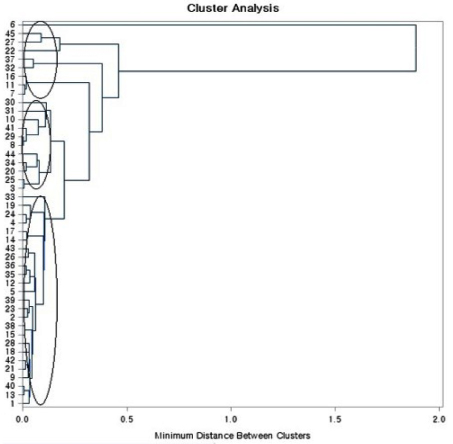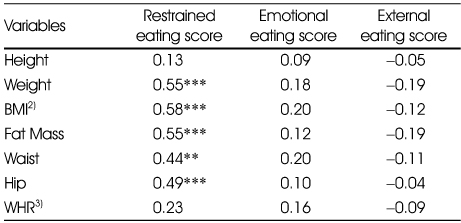Articles
- Page Path
- HOME > Korean J Community Nutr > Volume 21(2); 2016 > Article
-
Research Article
- Relationship between Eating Style and Food Intake of Healthy Female College Students during Chuseok Holidays
-
Seok-Young Kim

-
Korean Journal of Community Nutrition 2016;21(2):131-139.
DOI: https://doi.org/10.5720/kjcn.2016.21.2.131
Published online: April 30, 2016
Department of Food and Nutrition, Gyeongsang National University, Jinju, Korea.
- Corresponding author: Seok-Young Kim. Department of Food and Nutrition, Gyeongsang National University, 501 Jinjudaero, Jinjusi, Gyeongsangnam-do 52828, Korea. Tel: (055) 772-1432, Fax: (055) 772-1439, sykim@gnu.ac.kr
Copyright © 2016 The Korean Society of Community Nutrition
This is an Open-Access article distributed under the terms of the Creative Commons Attribution Non-Commercial License (http://creativecommons.org/licenses/by-nc/3.0/) which permits unrestricted non-commercial use, distribution, and reproduction in any medium, provided the original work is properly cited.
- 813 Views
- 2 Download
- 4 Crossref
Figure & Data
REFERENCES
Citations

- The Indicator of Emotional Eating and Its Effects on Dietary Patterns among Female Students at Qassim University
Razan M. Alharbi, Hend F. Alharbi
Nutrients.2023; 15(16): 3553. CrossRef - Comparison and Analysis of Dieting Practices Using Big Data from 2010 and 2015
Eun-Jin Jung, Un-Jae Chang
Korean Journal of Community Nutrition.2018; 23(2): 128. CrossRef - Body Image Perception and Eating Behaviors among Male Middle and High School Students according to Weight Status in Seoul
Bo-Mi Kim, Kyung-Hee Kim
Journal of the East Asian Society of Dietary Life.2018; 28(2): 123. CrossRef - The Analysis of a Diet for the Human Being and the Companion Animal using Big Data in 2016
Eun-Jin Jung, Young-Suk Kim, Jung-Wa Choi, Hye Won Kang, Un-Jae Chang
Clinical Nutrition Research.2017; 6(4): 256. CrossRef

Fig. 1
General characteristics and DEBQ1) scores of the study subjects (n=45)
1) DEBQ: Dutch Eating Behavior Questionnaire
2) BMI: Body mass index, WHR: Waist hip girth ratio
Energy and nutrient intake during Normal Day, Holiday, and Peak Holiday
1) Normal Day: September 20-24, 2015
2) Holiday: September 25-29, 2015
3) Peak Holiday: September26-28, 2015
4) CHO: Carbohydrate
ab: Values with the same letter within the same row are not significantly different at <0.05 by Duncan's multiple range test.
Correlation between anthropometry and DEBQ1) scores of the study subjects (n=45)
1) DEBQ: Dutch Eating Behavior Questionnaire
2) BMI: body mass index
3) WHR: waist hip girth ratio
**: p<0., ***: p<0.1 by Pearson's product-moment correlation
Correlation between Normal nutrient intake and DEBQ1) scores of the study subjects (n=45)
1) DEBQ: Dutch Eating Behavior Questionnaire.
*: p<0.05 by Pearson's product-moment correlation
Comparisons of energy and macronutrient intake among the clusters
1) Values with the same Roman character within the same column are not significantly different at p<0.05 by Kruskal wallis test and Wilcoxon signed rank test.
2) Values with the same alphabet within the same row are not significantly different at p<0.05 by Kruskal wallis test and Wilcoxon rank sum test.
3) CHO: Carbohydrate
Correlation between anthropometry and usual intake of the disinhibition cluster (n=11)
1) BMI:body mass index
2) WHR: waist hip girth ratio
*: p<0.05, **: p<0.01 by Spearman's rank correlation
Comparisons of anthropometry and DEBQ1) scores among eating style clusters
1) DEBQ: Dutch Eating Behavior Questionnaire.
All values are not significantly different at p<0.05 by Kruskal wallis test.
1) DEBQ: Dutch Eating Behavior Questionnaire 2) BMI: Body mass index, WHR: Waist hip girth ratio
1) Normal Day: September 20-24, 2015 2) Holiday: September 25-29, 2015 3) Peak Holiday: September26-28, 2015 4) CHO: Carbohydrate ab: Values with the same letter within the same row are not significantly different at <0.05 by Duncan's multiple range test.
1) DEBQ: Dutch Eating Behavior Questionnaire 2) BMI: body mass index 3) WHR: waist hip girth ratio **: p<0., ***: p<0.1 by Pearson's product-moment correlation
1) DEBQ: Dutch Eating Behavior Questionnaire. *: p<0.05 by Pearson's product-moment correlation
1) Values with the same Roman character within the same column are not significantly different at p<0.05 by Kruskal wallis test and Wilcoxon signed rank test. 2) Values with the same alphabet within the same row are not significantly different at p<0.05 by Kruskal wallis test and Wilcoxon rank sum test. 3) CHO: Carbohydrate
1) BMI:body mass index 2) WHR: waist hip girth ratio *: p<0.05, **: p<0.01 by Spearman's rank correlation
1) DEBQ: Dutch Eating Behavior Questionnaire. All values are not significantly different at p<0.05 by Kruskal wallis test.

 KSCN
KSCN








 PubReader
PubReader Cite
Cite


